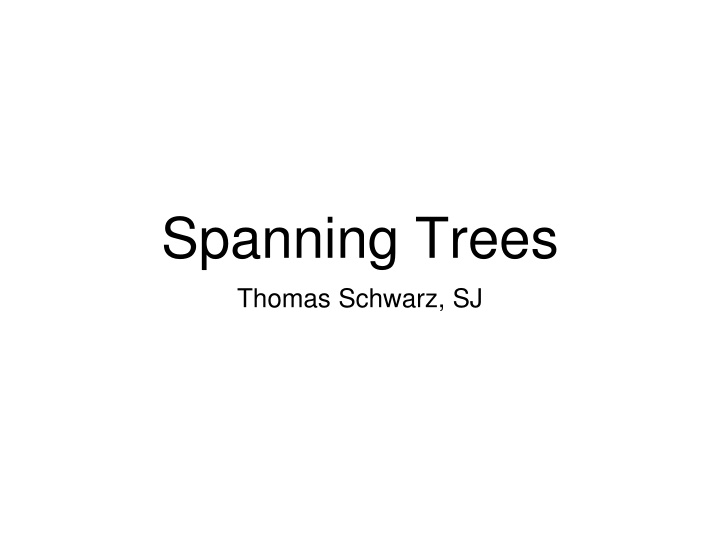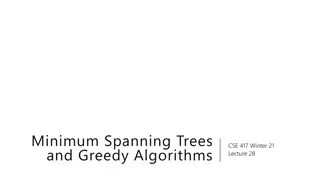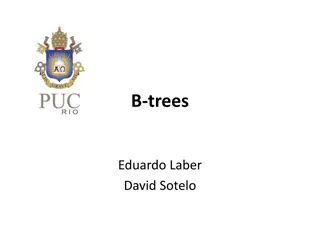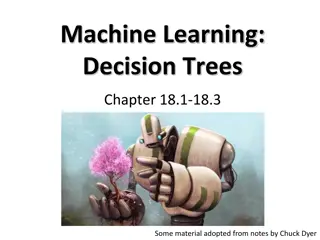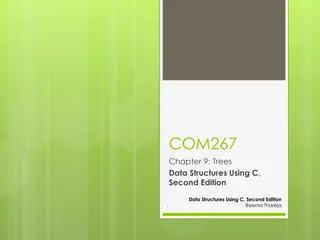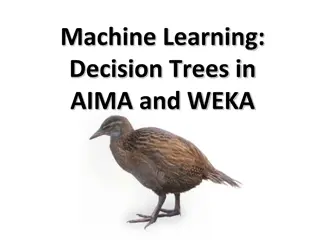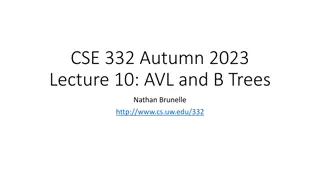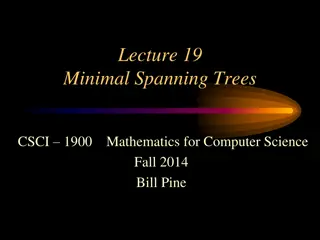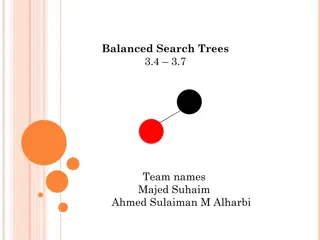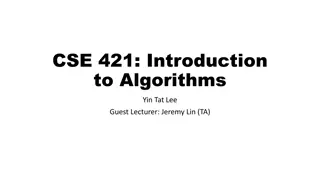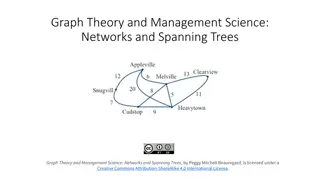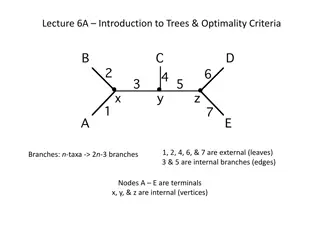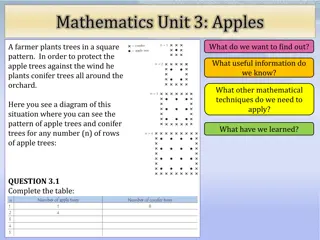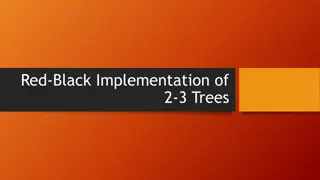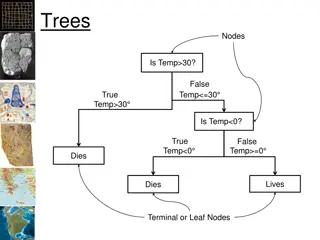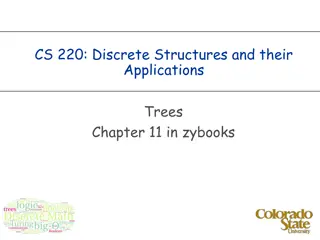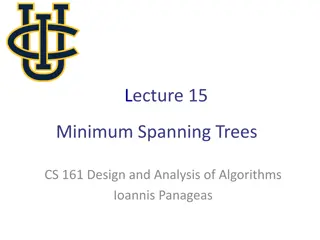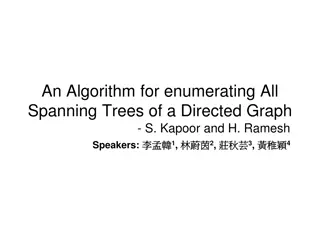Spanning Trees
This book by Thomas Schwarz provides a comprehensive overview of spanning trees, covering their fundamental concepts, properties, and applications in computer science and network theory. The author delves deep into the intricacies of spanning trees, making this a valuable resource for students, researchers, and professionals looking to enhance their understanding of graph theory and related fields. With clear explanations and insightful examples, this book offers a solid foundation for exploring the diverse aspects of spanning trees.
Download Presentation

Please find below an Image/Link to download the presentation.
The content on the website is provided AS IS for your information and personal use only. It may not be sold, licensed, or shared on other websites without obtaining consent from the author.If you encounter any issues during the download, it is possible that the publisher has removed the file from their server.
You are allowed to download the files provided on this website for personal or commercial use, subject to the condition that they are used lawfully. All files are the property of their respective owners.
The content on the website is provided AS IS for your information and personal use only. It may not be sold, licensed, or shared on other websites without obtaining consent from the author.
E N D
Presentation Transcript
Spanning Trees Thomas Schwarz, SJ
Problem Networking: LAN Switches are connected by links Cycles can create problems: Broadcast radiation A broadcast or multicast message is repeatedly received by the same switch and resend and resend and resend and resend
Problem Solution: Use an acyclic subgraph that contains all switches for broadcasting, multicasting, and in general for addressing purposes
Trees A tree is a graph that is: acyclic connects all vertices
Weighted Graphs We look at graphs where each edge has a weight Depending on application, some weights can be negative or all weights have to be positive
Weighted Graphs Other example:
Minimum Spanning Trees Given a weighted graph: Find a subset ? of edges such that connects all vertices is acyclic Total weight is minimal ?(?) = (?,?) ??(?,?) Called a minimum weight spanning tree, but "weight" is usually omitted
Minimum Spanning Trees Two greedy algorithms, Kruskal's and Prim's Use a loop invariant: Let ? be the set of edges currently selected Invariant: ? is a subset of some minimum spanning tree At each step of the algorithm: only add an edge (?,?) if the invariant remains true after inserting the edge Such an edge is a safe edge
Minimum Spanning Trees Generic MST algorithm 1. ? = 2. While ? is not a spanning tree 1.Find a safe edge 2.Add the safe edge to A 3.Return A
Minimum Spanning Trees A cut is a partition of the vertices of the graph
Minimum Spanning Trees Edges can "cross the cut"
Minimum Spanning Trees Edges are "light" if the cross the cut and no other edge crossing the cut has a smaller weight
Minimum Spanning Trees A cut respects ? if no edge of A crosses the cut
Minimum Spanning Trees Theorem: Let A be a subset of ? included in some minimum spanning tree, let (?,? ?) be a cut respecting A and let (?,?) be a light edge crossing the cut. Then this edge is safe
Minimum Spanning Trees Proof: We have a subgraph A that is part of a minimum spanning tree ? We have a minimum weight crossing edge (?,?) crossing the cut that separates A from the rest of the graph This set A has two different connected components and consists of red vertices T is given by the fatter edges
Minimum Spanning Trees Case 1: The edge is part of T Then there is nothing to show since adding the edge still gives us a subgraph that is part of a minimum spanning tree
Minimum Spanning Trees Case 2: The edge is not part of T Edges and vertices in A are red Edges in T are fat This includes the red edges u and v are at the lower left 5 8
Minimum Spanning Trees In this case, we need to construct a new minimum weight spanning tree Observe that there has to be an edge of T that crosses the cut Because we can travel from every node to every node in T and not all nodes are in A
Minimum Spanning Trees This edge in T that crosses the cut also has weight 2 in our example, but for sure, it has weight the weight of (?,?) There is another edge 5 8
Minimum Spanning Trees There has to be a path from ? to ? in ? because ? is a spanning tree
Minimum Spanning Trees This path has to have at least one edge that crosses the cut
Minimum Spanning Trees Take one of these edges and replace it with (?,?) in ? Call the result ?
Minimum Spanning Trees ? still connects all of the vertices If ?,? are two vertices that are connected in T by the deleted edge: Can reroute through the edge (?,?) ? has a weight changed by replacing the weight of (?,?) with the weight of the deleted edge But because the weight of (?,?) is minimal among all edges crossing the cut and the deleted edge also crossed the cut, ? weight can only be lower Thus, ? after adding the edge (?,?) fulfills still the invariant. qed
Kruskal's Algorithm Kruskal's algorithm works by joining subtrees Start out with all vertices being their own subtrees Thus, the cut is around all of the vertices While we have more than one subtree: We select a cutting edge (i.e. between different subtrees) with minimum weight This combines two subtrees
Kruskal's Algorithm Because Kruskal's algorithm only adds safe edges, it generates a minimum weight spanning tree How to organize it? We can order all of the edges by weight And then remove edges if they no longer are cutting edges Best way: Maintain vertices in the same subtree in a set Determine quickly whether something is in a set
Kruskal's Algorithm Best solution known to humanity for the disjoint set problem: have vertices organized by a directed edge to the "set leader" {?},{?},{?},{?},{?},{?},{?},{ }
Kruskal's Algorithm If we unite {?} and {?}, we have one point to the other {?,?},{?},{?},{?},{?},{?},{ }
Kruskal's Algorithm Same if we unite {?} and { } {?,?},{?},{?},{?},{?},{?, },
Kruskal's Algorithm If we ask whether b and g are in two different components, we follow the arrow and see whether the leaders are the same or not. {?,?},{?},{?},{?},{?},{?, },
Kruskal's Algorithm This can be optimized: There is the possibilities of having long chains {?,?,??},{?},{?},{?, },
Kruskal's Algorithm When we join, we connect one leader to the other leader Always make the larger set the head {?,?,??},{?,?} {?, ,?,?},
Kruskal's Algorithm When we do a look up: What is the head of c? Follow three links to get to 'h'
Kruskal's Algorithm When we do a look up: Reconnect the node and all we travel to directly to the head
Kruskal's Algorithm Best possible case: Every node points directly to the head
Kruskal's Algorithm With this "disjoint union data structure": Maintaining the disjoint set data structure costs ?(|?|) per operation where ? is a function that grows very slowly Kruskal's algorithm then runs in time ?(|?|log(|?|))
Prim's Algorithm Prim's algorithm starts ? at a single node and then adds edges to it. Thus, the intermediate results are always connected Maintain a priority queue of all other vertices The vertices are ordered by distance to ?
Prim's Algorithm We use the same example as before We can start at any node 3
Prim's Algorithm The priority queue tells us which node to select After selecting edge and node, we need to update some nodes Namely those in the adjacency list of the new node 3
